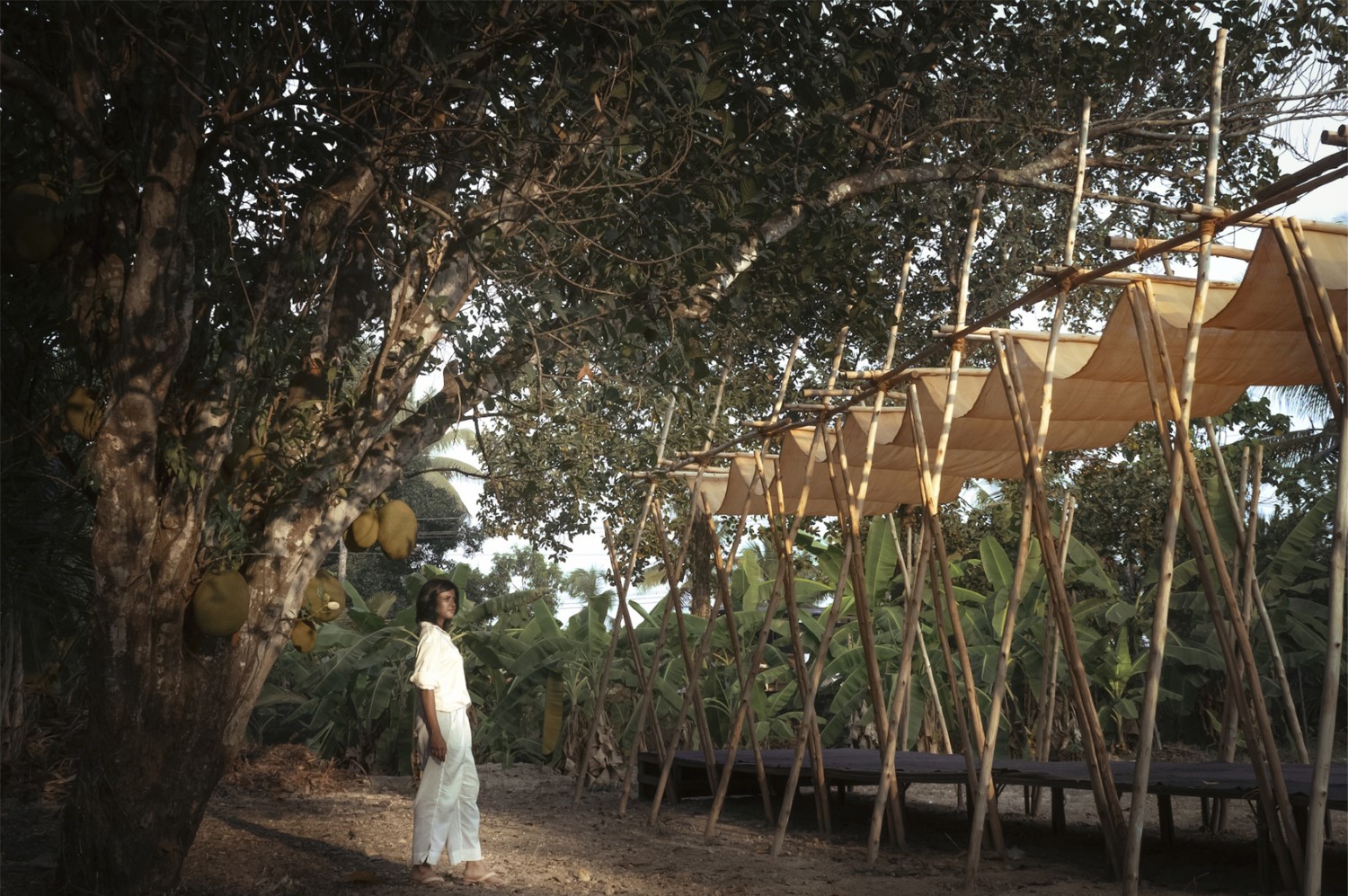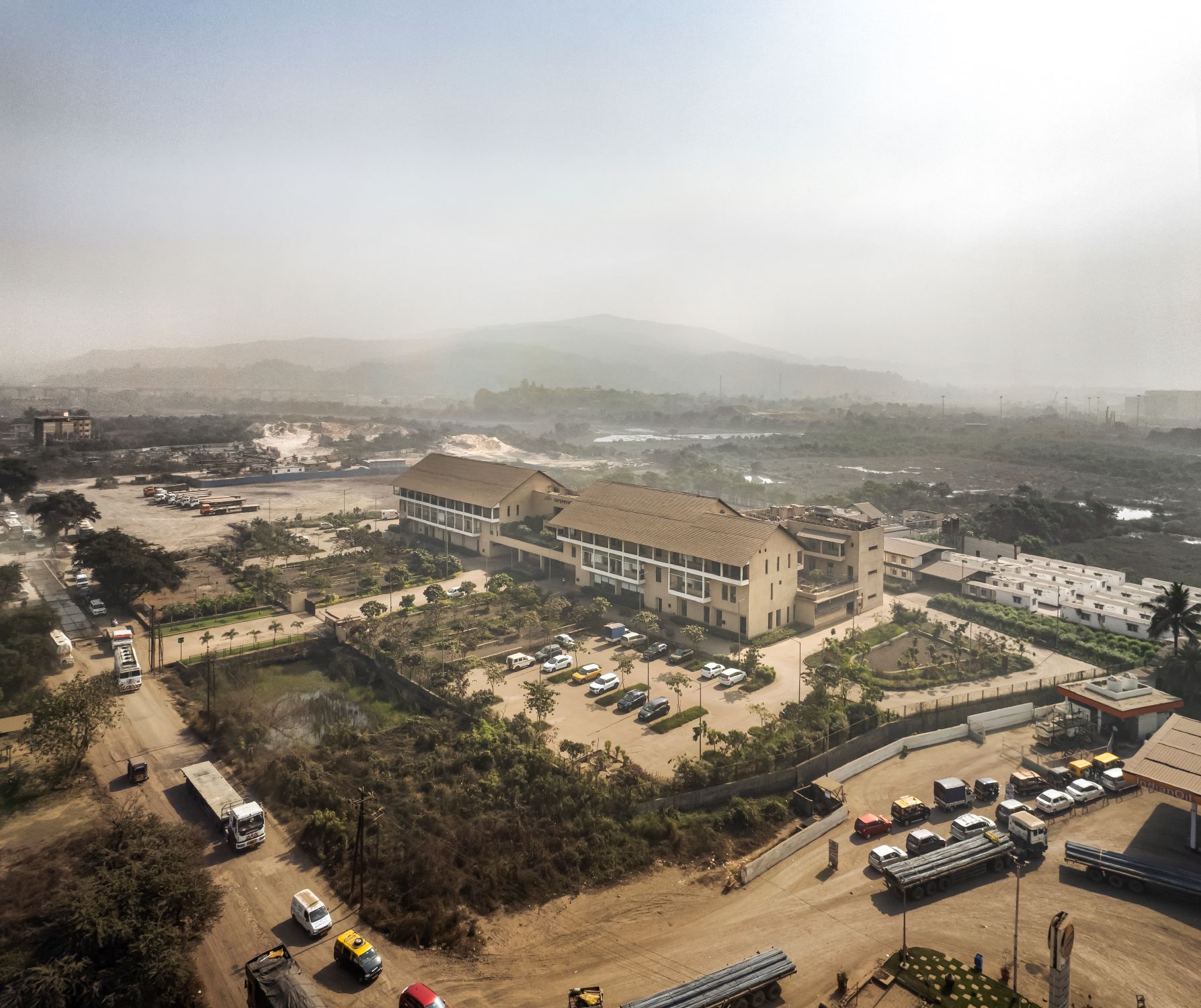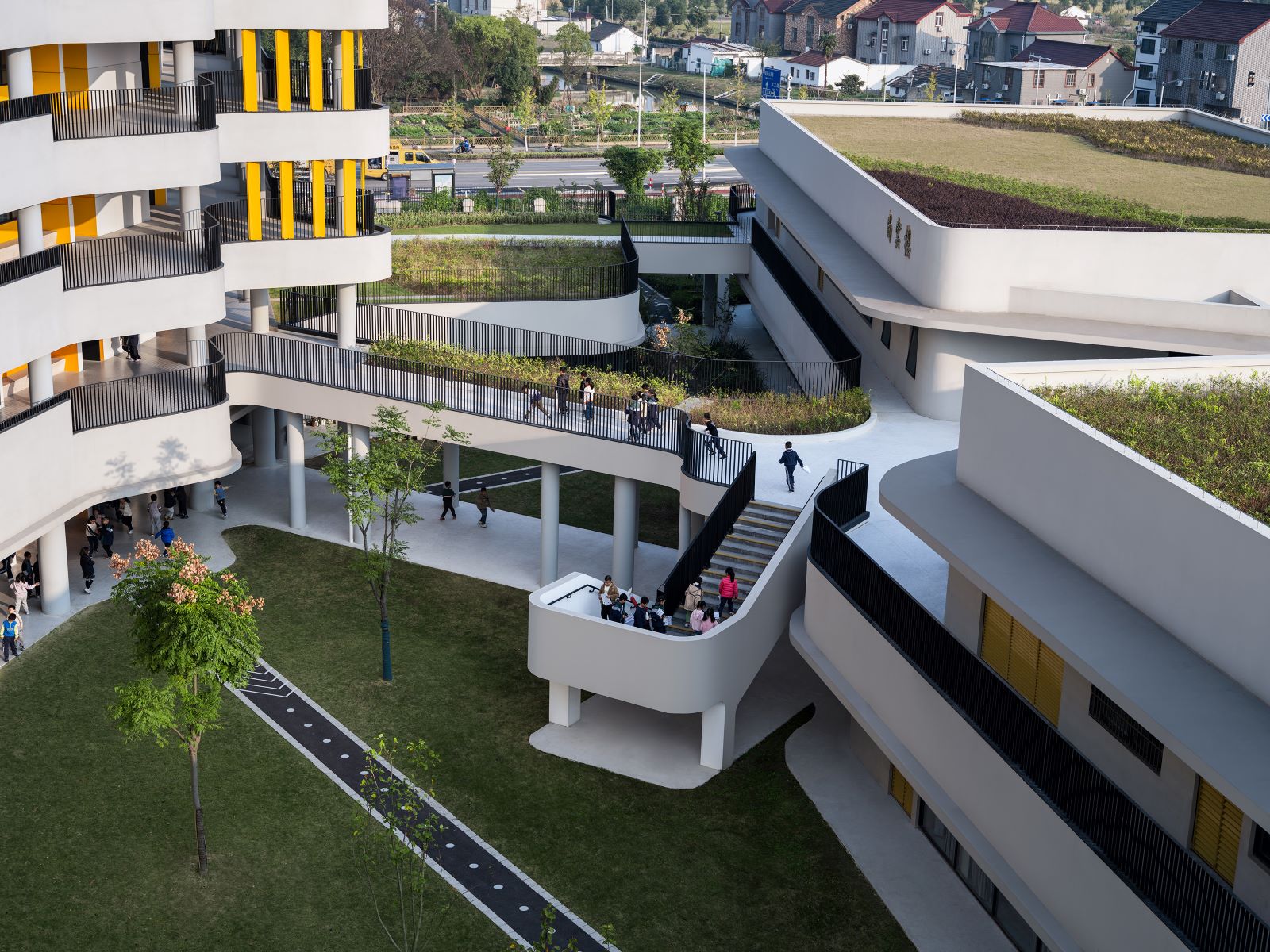The House Under The Nutmeg Tree, Cochin, by [ar&de]
Set in a 12.5 cent plot in Aluva, Kerala with 16 nutmeg and coconut trees spread all over the site, this residence for a couple, their two daughters and a pair of grandparents, was designed to preserve all but two trees, not just for environmental reasons but also to maintain the emotional connect the family had as their ancestors were nutmeg cultivators.
Questionnaires, interviews, discussions with the household and visits to their previous homes enabled a detailed understanding of the interests, routine, lifestyle, socializing habits, religious and cultural preferences, and various other spatial requirements of the family to which the design responds in many big and small ways including with space for gardening in privacy, privacy in the verandah, space for the daughters to read in cozy corners, a workspace to watch TV from for the man of the house, and so forth.
Spaces of different volumes unfold one after the other to create an engaging experience of walking in and about the various indoor spaces. This is reflected on the outside as a staggered and alternative massing of exposed brick and plastered walls. Another key feature of the house is the positioning and sizing of each of the windows which are particular for their location and purported use. Throughout the residence, there is a constant celebration of light using various modulations in the horizontal slabs. The multipurpose platform near the stair is another key feature of the house designed to contribute towards bringing the different generations of family together in a manner that invokes traditional spaces and ways of sitting. In addition to the thinna at the foyer and the one beside the stair, an alcove with a planter has been provided on the staircase landing as a place to sit and read at.
Considerable space has been saved in the kitchen by introducing counters that project perpendicularly from the wall and double up as a storage wall. The storage wall allowed us to do away with a store room and provide custom-sized shelves at an accessible height. This storage wall also hides parts of the work area thereby also making the work area feel spacious while also avoiding additional walls. Avoiding the conventional overhead cabinets above the kitchen counters allows for more openings and the room to feel more spacious.
The house has been oriented at an angle to the compound walls so as to avoid rectangular narrow spaces between the house and the compound wall, and instead create more triangular and dynamic spaces creating a greater sense of space when looking out of the windows or walking around the house. A courtyard-like garden space has been provided through the ‘C’ like configuration of the house, for the women of the house to grow vegetables and is visible from various parts of the house. A sit-out space has been provided facing this garden accessible from the formal dining space as a breakout space during family get-togethers and social events.
The windows, the abundance of natural light, the long lines of sight and other spatial strategies make the 3656 sqft house feel spacious yet simultaneously also enable awareness of each other and bring the family within earshot distance to each other in everyone’s daily routine. The house fulfils various specific cultural preferences of the family regarding privacy from visitors, neighbours and the prospective and existing couples living in the house.
Gallery
Drawings and Diagrams
![The House Under the Nutmeg Tree, Cochin, by [ar&de] 28 The House Under the Nutmeg Tree, Cochin, by [ar&de] 27](https://architecture.live/wp-content/uploads/2023/03/16-3.jpg)
![The House Under the Nutmeg Tree, Cochin, by [ar&de] 30 The House Under the Nutmeg Tree, Cochin, by [ar&de] 29](https://architecture.live/wp-content/uploads/2023/03/17-3.jpg)
![The House Under the Nutmeg Tree, Cochin, by [ar&de] 32 The House Under the Nutmeg Tree, Cochin, by [ar&de] 31](https://architecture.live/wp-content/uploads/2023/03/18-3.jpg)
![The House Under the Nutmeg Tree, Cochin, by [ar&de] 34 The House Under the Nutmeg Tree, Cochin, by [ar&de] 33](https://architecture.live/wp-content/uploads/2023/03/19-3.jpg)
![The House Under the Nutmeg Tree, Cochin, by [ar&de] 36 The House Under the Nutmeg Tree, Cochin, by [ar&de] 35](https://architecture.live/wp-content/uploads/2023/03/20-3.jpg)
![The House Under the Nutmeg Tree, Cochin, by [ar&de] 38 The House Under the Nutmeg Tree, Cochin, by [ar&de] 37](https://architecture.live/wp-content/uploads/2023/03/21-2.jpg)
![The House Under the Nutmeg Tree, Cochin, by [ar&de] 40 The House Under the Nutmeg Tree, Cochin, by [ar&de] 39](https://architecture.live/wp-content/uploads/2023/03/27-2.jpg)
![The House Under the Nutmeg Tree, Cochin, by [ar&de] 42 The House Under the Nutmeg Tree, Cochin, by [ar&de] 41](https://architecture.live/wp-content/uploads/2023/03/26-2.jpg)
![The House Under the Nutmeg Tree, Cochin, by [ar&de] 44 The House Under the Nutmeg Tree, Cochin, by [ar&de] 43](https://architecture.live/wp-content/uploads/2023/03/25-2.jpg)
![The House Under the Nutmeg Tree, Cochin, by [ar&de] 46 The House Under the Nutmeg Tree, Cochin, by [ar&de] 45](https://architecture.live/wp-content/uploads/2023/03/24-2.jpg)
![The House Under the Nutmeg Tree, Cochin, by [ar&de] 48 The House Under the Nutmeg Tree, Cochin, by [ar&de] 47](https://architecture.live/wp-content/uploads/2023/03/23-2.jpg)
![The House Under the Nutmeg Tree, Cochin, by [ar&de] 50 The House Under the Nutmeg Tree, Cochin, by [ar&de] 49](https://architecture.live/wp-content/uploads/2023/03/22-2.jpg)
![The House Under the Nutmeg Tree, Cochin, by [ar&de] 52 The House Under the Nutmeg Tree, Cochin, by [ar&de] 51](https://architecture.live/wp-content/uploads/2023/03/28-2.jpg)
![The House Under the Nutmeg Tree, Cochin, by [ar&de] 54 The House Under the Nutmeg Tree, Cochin, by [ar&de] 53](https://architecture.live/wp-content/uploads/2023/03/29-2.jpg)
![The House Under the Nutmeg Tree, Cochin, by [ar&de] 56 The House Under the Nutmeg Tree, Cochin, by [ar&de] 55](https://architecture.live/wp-content/uploads/2023/03/30-1.jpg)
![The House Under the Nutmeg Tree, Cochin, by [ar&de] 58 The House Under the Nutmeg Tree, Cochin, by [ar&de] 57](https://architecture.live/wp-content/uploads/2023/03/31.jpg)
![The House Under the Nutmeg Tree, Cochin, by [ar&de] 60 The House Under the Nutmeg Tree, Cochin, by [ar&de] 59](https://architecture.live/wp-content/uploads/2023/03/32.jpg)
![The House Under the Nutmeg Tree, Cochin, by [ar&de] 62 The House Under the Nutmeg Tree, Cochin, by [ar&de] 61](https://architecture.live/wp-content/uploads/2023/03/33.jpg)
Project Facts
Project Name: The House Under The Nutmeg Tree
Project Location: Cochin, Kerala
Typology: Residential

![The House Under the Nutmeg Tree, Cochin, by [ar&de] 2 The House Under the Nutmeg Tree, Cochin, by [ar&de] 1](https://i0.wp.com/architecture.live/wp-content/uploads/2023/03/02-3-686x1024.jpg?ssl=1)
![The House Under the Nutmeg Tree, Cochin, by [ar&de] 4 The House Under the Nutmeg Tree, Cochin, by [ar&de] 3](https://i2.wp.com/architecture.live/wp-content/uploads/2023/03/03-5-686x1024.jpg?ssl=1)
![The House Under the Nutmeg Tree, Cochin, by [ar&de] 6 The House Under the Nutmeg Tree, Cochin, by [ar&de] 5](https://i2.wp.com/architecture.live/wp-content/uploads/2023/03/04-4-682x1024.jpg?ssl=1)
![The House Under the Nutmeg Tree, Cochin, by [ar&de] 8 The House Under the Nutmeg Tree, Cochin, by [ar&de] 7](https://i1.wp.com/architecture.live/wp-content/uploads/2023/03/07-3-755x1024.jpg?ssl=1)
![The House Under the Nutmeg Tree, Cochin, by [ar&de] 10 The House Under the Nutmeg Tree, Cochin, by [ar&de] 9](https://i1.wp.com/architecture.live/wp-content/uploads/2023/03/09-2-1024x724.jpg?ssl=1)
![The House Under the Nutmeg Tree, Cochin, by [ar&de] 12 The House Under the Nutmeg Tree, Cochin, by [ar&de] 11](https://i0.wp.com/architecture.live/wp-content/uploads/2023/03/15-4-717x1024.jpg?ssl=1)
![The House Under the Nutmeg Tree, Cochin, by [ar&de] 14 The House Under the Nutmeg Tree, Cochin, by [ar&de] 13](https://i0.wp.com/architecture.live/wp-content/uploads/2023/03/14-2-890x1024.jpg?ssl=1)
![The House Under the Nutmeg Tree, Cochin, by [ar&de] 16 The House Under the Nutmeg Tree, Cochin, by [ar&de] 15](https://i0.wp.com/architecture.live/wp-content/uploads/2023/03/13-3-686x1024.jpg?ssl=1)
![The House Under the Nutmeg Tree, Cochin, by [ar&de] 18 The House Under the Nutmeg Tree, Cochin, by [ar&de] 17](https://i0.wp.com/architecture.live/wp-content/uploads/2023/03/05-4-686x1024.jpg?ssl=1)
![The House Under the Nutmeg Tree, Cochin, by [ar&de] 20 The House Under the Nutmeg Tree, Cochin, by [ar&de] 19](https://i2.wp.com/architecture.live/wp-content/uploads/2023/03/06-2-686x1024.jpg?ssl=1)
![The House Under the Nutmeg Tree, Cochin, by [ar&de] 22 The House Under the Nutmeg Tree, Cochin, by [ar&de] 21](https://i2.wp.com/architecture.live/wp-content/uploads/2023/03/10-1-686x1024.jpg?ssl=1)
![The House Under the Nutmeg Tree, Cochin, by [ar&de] 24 The House Under the Nutmeg Tree, Cochin, by [ar&de] 23](https://i1.wp.com/architecture.live/wp-content/uploads/2023/03/11-686x1024.jpg?ssl=1)
![The House Under the Nutmeg Tree, Cochin, by [ar&de] 26 The House Under the Nutmeg Tree, Cochin, by [ar&de] 25](https://i0.wp.com/architecture.live/wp-content/uploads/2023/03/12-2-1024x724.jpg?ssl=1)





